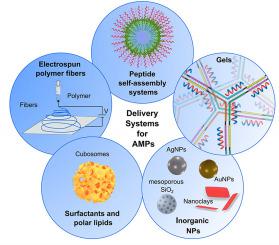Current Opinion in Colloid & Interface Science ( IF 8.9 ) Pub Date : 2023-04-26 , DOI: 10.1016/j.cocis.2023.101701 Lucrezia Caselli , Martin Malmsten

|
Non-healing wounds cause hundreds of thousands of deaths every year, and result in large costs for society. A key reason for this is the prevalence of challenging bacterial infections, which may dramatically hinder wound healing. With resistance development among bacteria against antibiotics, this situation has deteriorated during the last couple of decades, pointing to an urgent need for new wound treatments. In particular, this applies to wound dressings able to combat bacterial infection locally in wounds and impaired skin, including those formed by bacteria resistant to conventional antibiotics. Within this context, antimicrobial peptides (AMPs) are currently receiving intense interest. AMPs are amphiphilic peptides, frequently net positively charged, and with a sizable fraction of hydrophobic amino acids. Through destabilization of bacterial membranes, neutralization of inflammatory lipopolysaccharides, and other mechanisms, AMPs can be designed for potent antimicrobial effects, also against antibiotics-resistant strains, and to provide immunomodulatory effects while simultaneously displaying low toxicity. While considerable attention has been placed on AMP optimization and clarification of their mode(s)-of-action, much less attention has been paid on efficient AMP delivery. Considering that AMPs are large molecules, net positively charged, amphiphilic, and susceptible to infection-mediated proteolytic degradation, efficient in vivo delivery of such peptides is, however, challenging and delivery systems needed for the realization of AMP-based therapeutics. In the present work, recent developments regarding AMP delivery systems for treatment of wounds and skin infections are discussed, with the aim to link results from physicochemical studies on, e.g., peptide loading/release, membrane interactions, and self-assembly, with those on the biological functional performance of AMP delivery systems in terms of antimicrobial effects, cell toxicity, inflammation, and wound healing.
中文翻译:

用于抗菌肽的皮肤和伤口输送系统
无法愈合的伤口每年导致数十万人死亡,并给社会造成巨大成本。一个关键原因是具有挑战性的细菌感染的流行,这可能会极大地阻碍伤口愈合。随着细菌对抗生素产生耐药性,这种情况在过去几十年中恶化,表明迫切需要新的伤口治疗方法。特别是,这适用于能够抵抗伤口和受损皮肤局部细菌感染的伤口敷料,包括那些由对常规抗生素具有抗性的细菌形成的感染。在此背景下,抗菌肽 (AMP) 目前正受到强烈关注。AMP 是两亲性肽,通常带正电荷,并含有相当一部分疏水性氨基酸。通过细菌膜的去稳定化、炎性脂多糖的中和和其他机制,AMPs 可以设计为具有有效的抗菌作用,也可以对抗抗生素耐药菌株,并提供免疫调节作用,同时显示出低毒性。尽管人们对 AMP 优化和阐明其作用模式给予了相当大的关注,但对高效 AMP 交付的关注却少得多。考虑到 AMP 是大分子、带净正电荷、两亲性且易受感染介导的蛋白水解降解,高效 并提供免疫调节作用,同时显示出低毒性。尽管人们对 AMP 优化和阐明其作用模式给予了相当大的关注,但对高效 AMP 交付的关注却少得多。考虑到 AMP 是大分子、带净正电荷、两亲性且易受感染介导的蛋白水解降解,高效 并提供免疫调节作用,同时显示出低毒性。尽管人们对 AMP 优化和阐明其作用模式给予了相当大的关注,但对高效 AMP 交付的关注却少得多。考虑到 AMP 是大分子、带净正电荷、两亲性且易受感染介导的蛋白水解降解,高效然而,这种肽的体内递送是具有挑战性的,并且是实现基于 AMP 的疗法所需的递送系统。在目前的工作中,讨论了关于用于治疗伤口和皮肤感染的 AMP 递送系统的最新发展,目的是将物理化学研究的结果与例如肽加载/释放、膜相互作用和自组装等方面的结果联系起来。 AMP 递送系统在抗菌作用、细胞毒性、炎症和伤口愈合方面的生物学功能表现。



























 京公网安备 11010802027423号
京公网安备 11010802027423号